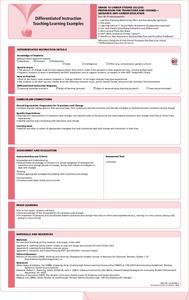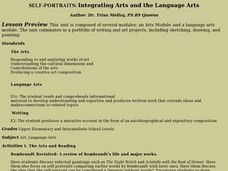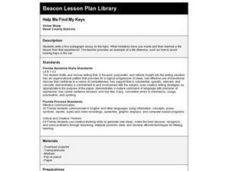EduGAINs
Preparation for Transitions and Change— Guidance and Career Education
Every hopeful in your class has gone through some kind of life change, from parents' divorce to a death in the family to moving up into another grade. Encourage them to discuss these changes, the skills they used and acquired during...
Curated OER
Greek Inquiry Report and Presentation
Sixth graders choose from a list of researchable inquiry questions. They engage in all phases of inquiry/research process.
Curated OER
Philadelphia Museum of Art
Students study paintings and use their knowledge of story elements to analyze the art. In this art analysis lesson plan, students review a novel for its elements. Students study the image At the Moulin Rouge: The Dance and discuss the...
Curated OER
Who Is That Masked Man?
Fifth graders write a narrative essay describing what happened in the classroom after a nystery person has visited.
Curated OER
Who Invented English Anyway?
In these English lesson plans, young scholars use video, the Internet and non-fiction essays to research the history of the English language. They write a short research paper and design a PowerPoint presentation showcasing their findings.
American Immigration Law Foundation
No Pretty Pictures
Here is a nice set of activities and discussion questions to accompany your class reading of No Pretty Pictures, a memoir of a young girl's experiences and struggle for survival during the Holocaust.
Japan Society
The “I” Novels in the Context of Early 20th-Century Japan
Although this lesson plan covers the rather obscure topic of the Japanese "I-novel", it also includes a great deal of historical information and material for an in-depth discussion of universal literary concepts. Specifically, young...
Curated OER
Marching to the Beat of a Different Drum
Students explore the American dream. For this contemporary music lesson, students analyze the lyrics of songs by Neil Diamond, Bruce Springsteen, and David Massengill. Students create 3-D representations of the American dream and write...
Curated OER
Using Word Processing to Create Graphic Organizers
Students create a graphic organizer and instructional rubric using word processing software. They conduct Internet research at the History Alive website, and publish an essay.
Curated OER
Peter and the Starcatchers: Multi-Genre Writing Assignment
Conclude your unit on Peter and the Starcatchers with an involved final writing project that requires learners to write persuasive pieces, compose short stories, create brochures about the setting of the novel, and choose from a list of...
Curated OER
Teacher Appreciation Week
Students write a biographical narrative about their favorite teacher. In this teacher appreciation lesson, students interview their favorite teacher and compile it into a biographical narrative including a teacher quote.
Curated OER
Self-portraits: Integrating Arts And the Language Arts
Students look into a mirror and draw their own self-portraits. Then they write a descriptive essay, describing the portrait and the features of their face.
Curated OER
What is Framing?
Middle schoolers practice framing issues. In this writing skills instructional activity, students participate in a classroom activity that requires them to look at specific topical issues by framing them. Middle schoolers then create...
Curated OER
Help Me Find My Keys
Fourth graders write a five-paragraph essay on the topic: What mistakes have you made and then learned a life lesson from that experience?
Curated OER
Nonfiction Genre Mini-Unit: Persuasive Writing
Should primary graders have their own computers? Should animals be kept in captivity? Young writers learn how to develop and support a claim in this short unit on persuasive writing.
Novelinks
The Tempest: Concept Analysis
Use a handy concept analysis guide as you begin your unit on William Shakespeare's The Tempest. With character descriptions, literary themes, and anticipated affective issues, the guide can help those new to using The Tempest craft a...
Annenberg Foundation
Gothic Undercurrents
Terror, mystery, excitement. American writers of the 19th century, including Nathaniel Hawthorne, Herman Melville, and Emily Dickinson, used these elements to create morally ambiguous tales that challenged the prevailing belief in...
Center for History Education
To What Extent Were Women's Contributions to World War II Industries Valued?
Women rose to the challenge when the nation's war effort called them—but were sent home when the GIs came back from World War II. Young historians consider whether the United States valued women's contributions during the war using a...
Curated OER
Poetics
In this online interactive philosophy worksheet, high schoolers respond to 10 short answer and essay questions about Poetics by Aristotle.
Curated OER
Beginning With Writing; Convey Ideas in Writing
Walk young writers through the process of creating an initial writing sample for their portfolio. They determine their purpose, organize their ideas, and then create a draft. The lesson includes worksheets and online resources to aid in...
Curated OER
Legacies of the Middle Passage
Students research the Atlantic slave trade during the 18th century. In this slave trade lesson, students read a narrative about colonial expansion in the Americas and the rise of slavery in the United States. Students write down what...
Curated OER
Teaching Night with Web Research Assignments
Students research the Holocaust. They read the autobiography, Night, by Elie Wiesel, conduct research on a child of the Holocaust, and write an essay comparing/contrasting the life of their selected child with that of Elie Wiesel.
Curated OER
The Ultimate Sacrifice
Students explore the concept of sacrifice during wartime. In this World War II lesson plan, students explore the Allied and Axis Powers that existed during the war. Students discover sacrifices that were made by both powers during the...
Curated OER
Demystifying Mood in Creative Writing
Students discover how writing is affected by mood and emotions. They learn proper mood descriptors and read sample pieces of writing to better explain mood.

























